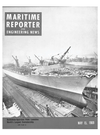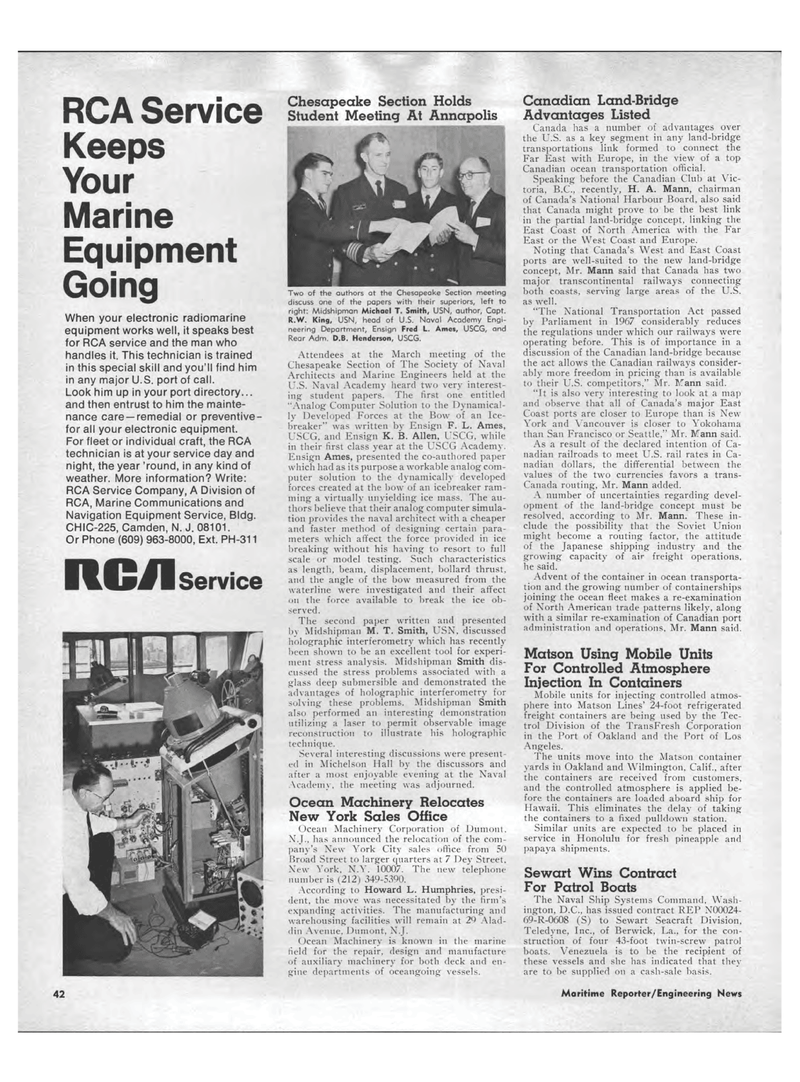
Page 38: of Maritime Reporter Magazine (May 15, 1969)
Read this page in Pdf, Flash or Html5 edition of May 15, 1969 Maritime Reporter Magazine
RCA Service Keeps Your Marine Equipment Going When your electronic radiomarine equipment works well, it speaks best for RCA service and the man who handles it. This technician is trained in this special skill and you'll find him in any major U.S. port of call. Look him up in your port directory... and then entrust to him the mainte-nance care ?remedial or preventive-for all your electronic equipment. For fleet or individual craft, the RCA technician is at your service day and night, the year 'round, in any kind of weather. More information? Write: RCA Service Company, A Division of RCA, Marine Communications and Navigation Equipment Service, Bldg. CHIC-225, Camden, N. J. 08101. Or Phone (609) 963-8000, Ext. PH-311 Service Chesapeake Section Holds Student Meeting At Annapolis Two of the authors at the Chesapeake Section meeting discuss one of the papers with their superiors, left to right: Midshipman Michael T. Smith, USN, author, Capt. R.W. King, USN, head of U.S. Naval Academy Engi-neering Department, Ensign Fred L. Ames, USCG, and Rear Adm. D.B. Henderson, USCG. Attendees at the March meeting of the Chesapeake Section of The Society of Naval Architects and Marine Engineers held at the U.S. Naval Academy heard two very interest-ing student papers. The first one entitled "Analog Computer Solution to the Dynamical-ly Developed Forces at the Bow of an Ice-breaker" was written by Ensign F. L. Ames, USCG, and Ensign K. B. Allen, USCG, while in their first class year at the USCG Academy. Ensign Ames, presented the co-authored paper which had as its purpose a workable analog com-puter solution to the dynamically developed forces created at the bow of an icebreaker ram-ming a virtually unyielding ice mass. The au-thors believe that their analog computer simula-tion provides the naval architect with a cheaper and faster method of designing certain para-meters which affect the force provided in ice breaking without his having to resort to full scale or model testing. Such characteristics as length, beam, displacement, bollard thrust, and the angle of the bow measured from the waterline were investigated and their affect on the force available to break the ice ob-served. The second paper written and presented by Midshipman M. T. Smith, USN, discussed holographic interferometry which has recently been shown to be an excellent tool for experi-ment stress analysis. Midshipman Smith dis-cussed the stress problems associated with a glass deep submersible and demonstrated the advantages of holographic interferometry for solving these problems. Midshipman Smith also performed an interesting demonstration utilizing a laser to permit observable image reconstruction to illustrate his holographic technique. Several interesting discussions were present-ed in Michelson Hall by the discussors and after a most enjoyable evening at the Naval Academy, the meeting was adjourned. Ocean Machinery Relocates New York Sales Office Ocean Machinery Corporation of Dumont. N.J., has announced the relocation of the com-pany's New York City sales office from 50 Broad Street to larger quarters at 7 Dey Street. New York. N.Y. 10007. The new telephone number is (212) 349-5390. According to Howard L. Humphries, presi-dent, the move was necessitated by the firm's expanding activities. The manufacturing and warehousing facilities will remain at 29 Alad-din Avenue, Dumont, N.J. Ocean Machinery is known in the marine field for the repair, design and manufacture of auxiliary machinery for both deck and en-gine departments of oceangoing vessels. Canadian Land-Bridge Advantages Listed Canada has a number of advantages over the U.S. as a key segment in any land-bridge transportations link formed to connect the Far East with Europe, in the view of a top Canadian ocean transportation official. Speaking before the Canadian Club at Vic-toria, B.C., recently, H. A. Mann, chairman of Canada's National Harbour Board, also said that Canada might prove to be the best link in the partial land-bridge concept, linking the East Coast of North America with the Far East or the West Coast and Europe. Noting that Canada's West and East Coast ports are well-suited to the new land-bridge concept, Mr. Mann said that Canada has two major transcontinental railways connecting both coasts, serving large areas of the U.S. as well. "The National Transportation Act passed by Parliament in 1967 considerably reduces the regulations under which our railways were operating before. This is of importance in a discussion of the Canadian land-bridge because the act allows the Canadian railways consider-ably more freedom in pricing than is available to their U.S. competitors," Mr. RCann said. "It is also very interesting to look at a map and observe that all of Canada's major East Coast ports are closer to Europe than is New York and Vancouver is closer to Yokohama than San Francisco or Seattle," Mr. Mann said. As a result of the declared intention of Ca-nadian railroads to meet U.S. rail rates in Ca-nadian dollars, the differential between the values of the two currencies favors a trans-Canada routing, Mr. Mann added. A number of uncertainties regarding devel-opment of the land-bridge concept must be resolved, according to Mr. Mann. These in-clude the possibility that the Soviet Union might become a routing factor, the attitude of the Japanese shipping industry and the growing capacity of air freight operations, he said. Advent of the container in ocean transporta-tion and the growing number of containerships joining the ocean fleet makes a re-examination of North American trade patterns likely, along with a similar re-examination of Canadian port administration and operations. Mr. Mann said. Matson Using Mobile Units For Controlled Atmosphere Injection In Containers Mobile units for injecting controlled atmos-phere into Matson Lines' 24-foot refrigerated freight containers are being used by the Tec-trol Division of the TransFresh Corporation in the Port of Oakland and the Port of Los Angeles. The units move into the Matson container yards in Oakland and Wilmington, Calif., after the containers are received from customers, and the controlled atmosphere is applied be-fore the containers are loaded aboard ship for Hawaii. This eliminates the delay of taking the containers to a fixed pulldown station. Similar units are expected to be placed in service in Honolulu for fresh pineapple and papaya shipments. Sewart Wins Contract For Patrol Boats The Naval Ship Systems Command, Wash-ington, D.C., has issued contract REP N00024-69-R-0608 (S) to Sewart Seacraft Division, Teledyne, Inc., of Berwick, La., for the con-struction of four 43-foot twin-screw patrol boats. Venezuela is to be the recipient of these vessels and she has indicated that they are to be supplied on a cash-sale basis. 42 Maritime Reporter/Engineering News

 37
37

 39
39
